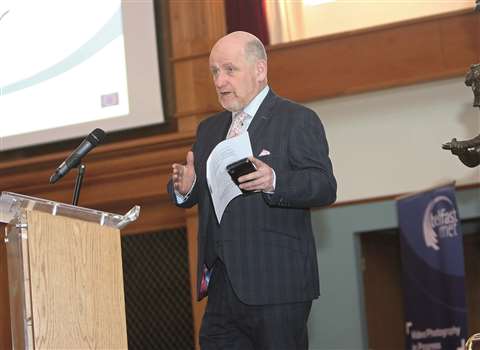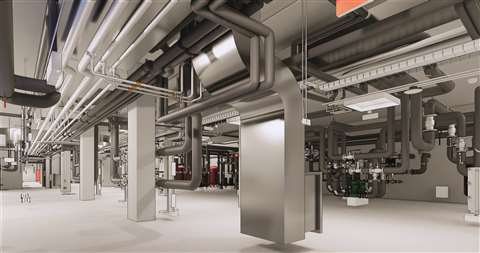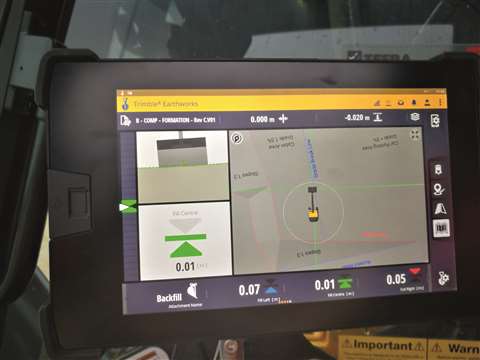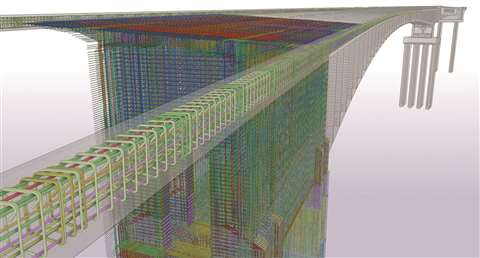BIM: a game-changing technology?
29 September 2021
What are the benefits of building information modelling and what is its role going forward?
It is widely accepted that digitalisation is a game-changing strategy that will empower the construction sector to thrive and deliver the expertise for sustainable energy skills.
That is the view of Paul McCormack, BIMCert programme manager at Belfast Metropolitan College in Northern Ireland.
 Paul McCormack, BIMCert programme manager at Belfast Metropolitan College in Northern Ireland.
Paul McCormack, BIMCert programme manager at Belfast Metropolitan College in Northern Ireland.
McCormack believes that transforming the EU Construction Sector to be greener, consume less energy and to reduce the carbon footprint of the sector, will be driven by the growing market for digitalisation and data and by legislated carbon reduction targets but it will all be achieved through upskilling the built environment workforce. Building information modeling (BIM) is the backbone of the new ‘informed’ way of working triggered and targeted by the digitalisation opportunities presented to the sector.
A BIM model of the internal utilities of a buildi“The challenge for industry is how to engage in the digitalisation journey, where is the nest starting point and how do you navigate a journey when you are unsure of the destination?” says Paul.
“As with any journey it is vital that you get the fundamentals right. The digitalisation journey is no different, get the right training materials, suitably prepared and correctly packaged for the audience, ensure the learning process fits and is well mapped out.
A future-fit industry
“Whilst technology affords us the chance to do many things, it is essential to get the theory and practice right first. Ensuring the correct pedagogical structure for the process is the foundation of the learning process regardless of the delivery mechanism.”
“In the post, Covid-19 crisis there will not be a return to pre-pandemic normality; many of the previous systems, structures and jobs have disappeared and will not return. It is therefore imperative that to help kick start the economy and to take full benefit from the emerging low carbon economy and other opportunities, all training tools, mechanisms and channels developed must be future fit in design, content, delivery and accreditation.
“In the current crisis individuals, industries and governments are being affected on an unprecedented scale in the current crisis. Our challenge is to develop training materials and modules for the new economy and marry these with new forms of learning. This approach enables industry and workers to start their digitalisation journey learning learn new skills whilst also accelerating the process.” BIMcert is a project based upon three steps, aimed at providing a large-scale training & qualification scheme providing the requisite skills for the entire construction supply chain to:
 A BIM model of the internal utilities of a building.
A BIM model of the internal utilities of a building.
1. Enable collaborative working to improve access to and the transition from design to development and delivery of both new build and renovation to achieve energy efficient near zero buildings (embedded energy)
2. Achieve efficient and effective ongoing management of the building in terms of energy and fabric (operational energy)
3. Use Building Information Modelling (virtual construction) as the enabling methodology and tool (sustainable energy)
“The construction sector is increasingly struggling with how to gather and se data in a co-ordinated fashion across the entire sector supply chain. By upskilling the workforce initially to master the digital fundamentals and then to utilise BIM to gather the data, the sector can then organise, store and extract value from the data, leading to greener construction and enabling net zero carbon footprints in construction. BIM is simply a repository of energy information of buildings, accessible and usable by all stakeholders in a systemic and coordinated environment,” he continues.
“BIM is an enabler and a priority for companies to secure a basic grasp of, but in reality the level of knowledge and use of BIM will differ from one company to another depending on their position on the construction value chain. Whilst large multinational companies will have resources for a dedicated BIM department, SMEs will require this to be an ‘add on’ to someone’s job description. Therefore, the BIM adoption levels, and development routes are different for each player and the resources available need to reflect this. Every company will adopt different BIM approaches depending on need and capacity. However, every company will require a basic grounding in BIM.
“Now is the time for companies to develop and implement their specific needs and opportunity driven digital strategy with BIM at the heart. The starting point for this journey is getting the fundamentals in place.”
Building better together
Construction software specialist Trimble feels that the potential of BIM is often underestimated.
“Many people think of BIM as a digital formula for producing rich designs and visualisations. BIM is a lot more than just a better way of modelling objects, components and structures. From the earliest days of its inception, the aims of BIM were no less than to transform construction and the ways construction stakeholders work together in the actual building process, not just the design phase.
 Construction software specialist Trimble believes the potential of BIM is underestimated.
Construction software specialist Trimble believes the potential of BIM is underestimated.
“BIM methodology allows the construction process to start before the design is ready. When the contractor has access to design data in the early phases and can interact and give feedback to the design team, a two-way interaction develops between design and construction which improves the project progress, planning and reduces rework.”
One thing that Trimble has noticed in the context of BIM is how construction has changed in recent years.
“The entire construction process has become much more information-driven, which is why our strategy is centered around the concept of ‘constructible data.’
Working with shared and coordinated construction data enables all stakeholders to have the information they need to succeed and to ensure other stakeholders on a project also have what they need. The idea is to identify and solve issues related to physical construction up front and digitally with as much detail as possible. BIM means a project has multiple federated models (from architecture, layout, structural engineering,) that are shared so different project stakeholders can better coordinate as a team, which leads to meaningful improvements to delivery of the completed project.
According to Trimble, analysis run on BIM and non-BIM projects in Norway shows that one of the obvious benefits is that when the BIM design process is run in a shared environment, with a continuous cross domain check, there is a significant reduction in the number of conflicts between domains. Also, when work in the field is connected to the office, for instance, project progress can directly inform project managers and even the accounting systems. Studies have shown that the costs of rework in construction can be up to 25% of the contract value and 10% of the total cost of the project, often due to management, planning, and communication issues. Integrating the field and the office in a connected project makes it easier for crews on site to better understand the designer’s intent, which in turn can reduce errors.
 Adopting BIM is seen as a key strategy for construction businesses emerging from the Covid-19 pandemic.
Adopting BIM is seen as a key strategy for construction businesses emerging from the Covid-19 pandemic.
Another quality and efficiency step, says Trimble, is when construction machinery is connected to the model that is always up to date. The company has seen examples of utilizing constructible models to guide layout and fabrication workflows with robotic total stations and directly guiding earthmoving equipment through machine control. When the machines in the field are equipped with 3D-machine control, a huge benefit can be gained from directly connecting to the model to get the right design and the updates in real time and feeding back real time data while they execute. Therefore, it is not just important to work with BIM but in an open BIM environment that allows collaboration between several technologies.
Getting it right first time
Fabio Ponzio, vice president, building solutions at Hexagon’s Geosystems division, says his company has various solutions supporting the lifecycle of BIM as well. For example, Scan-to-BIM, the process of digitally capturing an existing building or construction site with 3D laser scanning technology, can be used to create a BIM model of an existing building.
 Fabio Ponzio – vice president, Building Solutions, Hexagon Geosystems.
Fabio Ponzio – vice president, Building Solutions, Hexagon Geosystems.
Scan-to-BIM contributes to time and cost savings by increasing the speed of accurate data collection. It also positively affects workers’ safety by allowing them to remain at a distance while digitally capturing complex areas and environments. Deploying 3D laser scanning solutions and software also leads to less rework, as inaccuracies are avoided at the initial planning stage instead of being incorporated into the project itself — which will cause problems later.
“Having a visual model or digital twin also means that everyone involved in the project can understand and explore the site without making visits — resulting in a decrease in machine use and harmful CO2 emissions and the number of face-to-face interactions as we continue to emerge from the pandemic. The collaborative BIM process also allows everyone on the team to work from the same detailed and accurate information source, making problems easier to identify and faster to resolve.
“As the construction industry emerges from the global pandemic, digital solutions that connect sites and teams easily and quickly will be key, including adopting BIM throughout the construction process”.
To be fast and accurate
Asked whether BIM is currently seen as a contract-winning tool for large contractors, or whether it is now better understood and being used to greater purpose within both the tier one and SME community, Ponzio says he believes geography is an important factor.
“BIM adoption varies regionally. Some countries are further ahead as BIM has been mandated by the government. Still, many architects, engineers and contractors are using more traditional CAD methodology as well. Many companies are using CAD and BIM depending on the project. We see smaller and bigger companies adopting BIM and investing in tools like reality capture for Scan-to-BIM workflows.
“For example, in Spain, Sertogal SL used the Leica Geosystems’ reality capture solutions to create a BIM model that guided the remodelling and expansion of the electrical substation of Mera in the province of Ourense — part of an ambitious initiative to partly absorb the energy production generated by 17 new wind farms planned in the region. In the Netherlands, engineering firm BIM4ALL, a member of the Brevo Group, was commissioned to document sewer pits across the whole country — around 10% of 80 million of these in need of replacement due to corrosion from hydrogen sulfide gas. To achieve this, BIM4ALL deployed the Leica RTC360 3D laser scanner to document 5-metre-deep pits — capturing two million points per second; each pit only took 15 to 30 minutes to complete. Based on this scanning data, BIM4ALL can create accurate BIM models of existing conditions as well.”
On track with BIM at Naples Central StationMinnucci Associati engineering studio has produced a complete IFC - BIM model of the central train station of Naples in Piazza Garibaldi with millions of objects containing detailed information, technical data sheets, structural/thermal data and much more, with the aim of optimising network rails’ management, enhancement and maintenance. The overall model, consisting of a federation of over 50 IFC models, has been uploaded on the usBIM.platform CDE, which allows you to view various models and objects associated to multiple documents, information and data. The usBIMplatform enables the user to view such a complex model even with a normal browser, such as Google Chrome or Internet Explorer, etc. In this specific case, it is possible to access the same model directly from the GIS Open BIM from the platform. Immersive virtual reality experience The virtual effects are commonly created by special viewers, such as VR headsets. The spectator is given a complete feeling of reality and can look around the artificial scenario. The dynamic integration between BIM architectural design and immersive virtual reality allows architects and designers to have a much better understanding of their project and, perhaps more importantly, improve communication and client collaboration. VR technology has truly impacted the design experience allowing the various stakeholders to take part to the digital model creation and maintenance process. It follows an interaction with the client who can be directly involved in the decision-making process during the design phase, in terms of simple decisions such as furnishing or finishes selection or more demanding functional-architectural choices. In addition to the BIM model of the Garibaldi station, a digital model of the Naples to Rome line has also been produced. The model reached a high level of detail for each railway object inserted and the signage details, thanks to the possibility of assigning technical datasheet and other type of information to the IFC model objects. |
STAY CONNECTED



Receive the information you need when you need it through our world-leading magazines, newsletters and daily briefings.
CONNECT WITH THE TEAM








